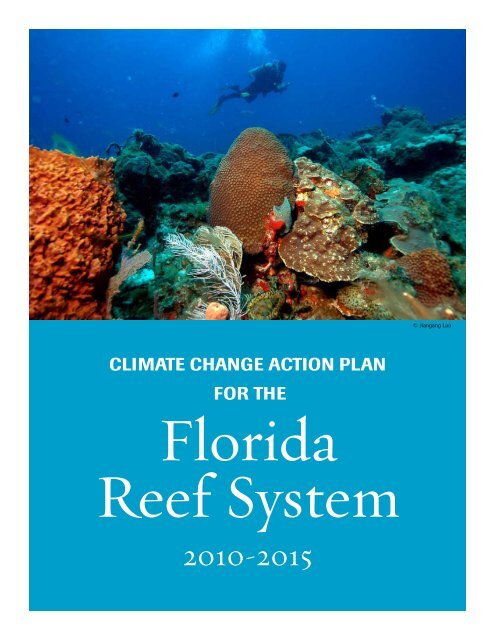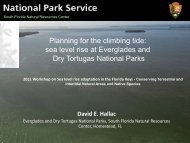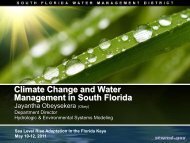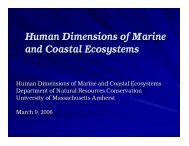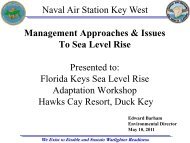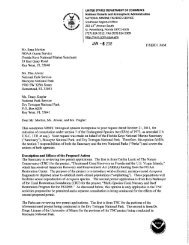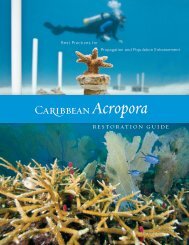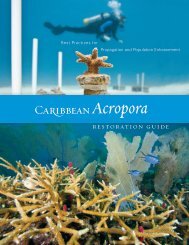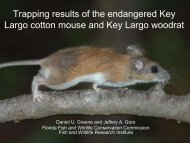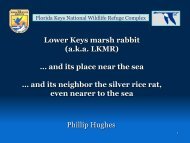Climate Change Action Plan for the Florida Reef System 2010-2015
Climate Change Action Plan for the Florida Reef System 2010-2015
Climate Change Action Plan for the Florida Reef System 2010-2015
You also want an ePaper? Increase the reach of your titles
YUMPU automatically turns print PDFs into web optimized ePapers that Google loves.
Management of <strong>Florida</strong>’s <strong>Reef</strong> <strong>System</strong>It is important to understand that reefs arepart of <strong>the</strong> foundation of South <strong>Florida</strong>’senvironment, culture and economy. Without<strong>the</strong> reefs giving life to <strong>the</strong> sea, fisheries, diving,snorkeling, and tourism will dwindle. Theloss of <strong>Florida</strong>’s coral reefs would irrevocablychange <strong>the</strong> South <strong>Florida</strong> way of life especiallyin <strong>the</strong> Keys, which are not as economicallydiversified as <strong>the</strong> sou<strong>the</strong>ast <strong>Florida</strong> mainland.Two major factors will dictate <strong>the</strong> futurehealth of <strong>the</strong> reef: <strong>the</strong> rate and extent ofclimate change and <strong>the</strong> resilience of <strong>Florida</strong>’scoral reef ecosystem to that change. While<strong>the</strong> issue of climate change mitigation islargely a matter <strong>for</strong> international, national,and state policy, <strong>the</strong> resilience of <strong>Florida</strong>’scoral reefs is under <strong>the</strong> direct influence oflocal management strategies and reef users’activities.Fortunately, reef managers actively protect<strong>Florida</strong> reefs so that <strong>the</strong>y can continue to bestrong environmental and economic drivers.The realization of climate change relatedthreats makes <strong>the</strong> need <strong>for</strong> resilience-basedmanagement of <strong>the</strong> <strong>Florida</strong> <strong>Reef</strong> <strong>System</strong>even more important, but also presents newchallenges and demands a more coordinatedand regionally effective plan.It is not a matter of simply consolidating reefmanagement under one agency, but ra<strong>the</strong>rbuilding on <strong>the</strong> expert knowledge and abilitiesof local, state, and federal reef managers bycoordinating <strong>the</strong>ir actions across <strong>the</strong> entire<strong>Florida</strong> <strong>Reef</strong> <strong>System</strong>. To secure <strong>the</strong> futureof <strong>Florida</strong>’s coral reefs it is essential that allagencies responsible <strong>for</strong> managing <strong>the</strong> reefs,o<strong>the</strong>r marine natural resources, adjacentlands, and watersheds do everything possibleto restore and maintain <strong>the</strong> resilience of <strong>the</strong>ecosystem.A <strong>Climate</strong> <strong>Change</strong> <strong>Action</strong> <strong>Plan</strong><strong>for</strong> <strong>the</strong> <strong>Florida</strong> <strong>Reef</strong> <strong>System</strong>—<strong>2010</strong>-<strong>2015</strong>The <strong>Action</strong> <strong>Plan</strong> identifies ways to increasereef resilience to climate change and minimizenegative impacts on reef-dependent industriessuch as diving and snorkeling tourism, andcommercial and recreational fishing. Builton well-established resilience principles,it outlines a holistic, adaptable five-yearprogram that <strong>Florida</strong>’s reef managers canundertake in collaboration with reef users ando<strong>the</strong>r stakeholders to minimize <strong>the</strong> damageand associated impacts of climate change. It isintended to be adaptable and updated at leastevery five years.Coral damaged by boat grounding © <strong>Florida</strong> Keys NationalMarine SanctuaryThis <strong>Florida</strong>-specific <strong>Action</strong> <strong>Plan</strong> adds directhabitat degradation (e.g. boat groundings,destructive anchoring, diving and coastaldevelopment) to <strong>the</strong> list of impacts addressedin <strong>the</strong> NOAA CRCP 2009 frameworkwhich focused on climate change, overfishing,and land based sources of pollution. Italso includes <strong>the</strong> Sou<strong>the</strong>ast <strong>Florida</strong> Coral<strong>Reef</strong> Initiative (SEFCRI) priority actionsto increase resilience, as <strong>the</strong>se are specificobjectives likely to be adopted across <strong>the</strong>South <strong>Florida</strong> region.4 <strong>2010</strong>–<strong>2015</strong> — <strong>Climate</strong> <strong>Change</strong> <strong>Action</strong> <strong>Plan</strong> <strong>for</strong> <strong>the</strong> <strong>Florida</strong> <strong>Reef</strong> <strong>System</strong>
<strong>Florida</strong> is exemplary in terms of marine managed areas and hosts one of <strong>the</strong> first designated marine protected areas in<strong>the</strong> world, John Pennekamp Coral <strong>Reef</strong> State Park established in 1963.In addition, many of <strong>Florida</strong>’s coral reefs are protected and managed within <strong>the</strong> <strong>Florida</strong> Keys National Marine Sanctuary,Dry Tortugas National Park and Biscayne National Park, John U. Lloyd Beach State Park, St. Lucie Inlet Preserve StatePark, and four coastal National Wildlife Refuges in <strong>the</strong> five county region—Great White Heron, Key West, National KeyDeer, and Hobe Sound.Most of <strong>the</strong> reefs of <strong>the</strong> nor<strong>the</strong>rn extension of <strong>the</strong> <strong>Florida</strong> <strong>Reef</strong> <strong>System</strong>, from <strong>the</strong> nor<strong>the</strong>rn border of Biscayne NationalPark in Miami-Dade County to <strong>the</strong> St. Lucie Inlet in Martin County, are overseen by <strong>the</strong> <strong>Florida</strong> Department ofEnvironmental Protection’s Coral <strong>Reef</strong> Conservation Program which is developing new management strategies <strong>for</strong> <strong>the</strong>region through <strong>the</strong> Sou<strong>the</strong>ast <strong>Florida</strong> Coral <strong>Reef</strong> Initiative.<strong>Climate</strong> <strong>Change</strong> <strong>Action</strong> <strong>Plan</strong> <strong>for</strong> <strong>the</strong> <strong>Florida</strong> <strong>Reef</strong> <strong>System</strong> — <strong>2010</strong>–<strong>2015</strong>5
Stony corals, soft corals, sponges and reef fish on a healthy <strong>Florida</strong> reef © Jiangang LuoSummary of <strong>the</strong> 10 top priority climatechange actions <strong>for</strong> <strong>the</strong> <strong>Florida</strong> <strong>Reef</strong> system:(<strong>for</strong> more detailed outcomes and action steps,please see Appendix 1.)•• Work with <strong>Florida</strong>’s coral reef managementjurisdictions to improve regulations andmanagement that facilitate adaptation toclimate change and ocean acidification. (10)Evaluate and revise existing programs andstrategies (e.g. <strong>Florida</strong> Keys NationalMarine Sanctuary Water QualityProtection Program and <strong>the</strong> existing marineprotected areas in <strong>the</strong> <strong>Florida</strong> <strong>Reef</strong> <strong>System</strong>)to optimize <strong>the</strong>ir effectiveness and make<strong>the</strong>m more robust in <strong>the</strong> context of creatingresilience to climate change. (1, 12, 17)•• Develop and implement a marine zoningplan that incorporates resilience-basedconcepts to provide maximum protectionfrom non-climate stresses <strong>for</strong> all reef typesand associated habitats in <strong>the</strong> <strong>Florida</strong><strong>Reef</strong> <strong>System</strong>. This plan must also ensureconnectivity between reefs and <strong>the</strong>irassociated nursery habitats (1, 2, 4, 7, 8).•• Integrate climate change predictions anduncertainties into <strong>Florida</strong>’s comprehensiveplanning laws and procedures, particularlyin coastal areas. Include sea level riseadaptation and mitigation planning incounty and municipal comprehensiveplans. (15)•• Continue and expand <strong>the</strong> FRRPdisturbance response monitoring (DRM)and Mote Marine Laboratory’s BleachWatch activities throughout <strong>the</strong> entire fivecounty(Monroe, Miami-Dade, Broward,Palm Beach and Martin) <strong>Florida</strong> <strong>Reef</strong><strong>System</strong>. (1)•• Decrease <strong>the</strong> likelihood of negative fishing,diving, and o<strong>the</strong>r reef use impacts to keyhabitats and important functional groupsof plants and animals (e.g. herbivores) byincreasing law en<strong>for</strong>cement presence andregulatory compliance. (1, 4, 8, 10, 14)6 <strong>2010</strong>–<strong>2015</strong> — <strong>Climate</strong> <strong>Change</strong> <strong>Action</strong> <strong>Plan</strong> <strong>for</strong> <strong>the</strong> <strong>Florida</strong> <strong>Reef</strong> <strong>System</strong>
•• Develop scientific climate change factsheets tailored <strong>for</strong> reef users, communitymembers, visitors, elected officials,businesses and industries to increaseunderstanding of and support <strong>for</strong> actionsto increase resilience. Use multipleoutlets (e.g. news media, radio, brochures,community meetings, social networks, blogsand websites) to communicate facts. (12)•• Forecast <strong>the</strong> potential social and economiceffects of climate change on reef-dependentindustries and communities to measure <strong>the</strong>irvulnerability and resilience and determinecost-to-benefit ratios of any proposedclimate change mitigation/adaptationmeasures. (2, 12) Support <strong>the</strong> creation ofindustry-specific business adaptation plans<strong>for</strong> diving, fishing and general tourismindustries and training opportunities thatfacilitate any necessary adaptation.•• Increase awareness and appreciation of <strong>the</strong><strong>Florida</strong> <strong>Reef</strong> <strong>System</strong> and encourage a senseof urgency <strong>for</strong> its sound management andprotection.(1,8)•• Ensure long term, question-drivenmonitoring of environmental variableslinked to coral bleaching and o<strong>the</strong>r climatechange impacts throughout <strong>the</strong> <strong>Florida</strong><strong>Reef</strong> <strong>System</strong>. Integrate monitoring resultsinto a coastal observing network thatin<strong>for</strong>ms <strong>the</strong> evolving questions underlyingprotection and management of marineresources. (1, 3, 5) For example, changes inlocalized acidification linked to watermanagement practices need to be studiedand monitored in <strong>Florida</strong> to see how <strong>the</strong>yrelate to global changes in ocean acidity.•• Develop scientific models of <strong>the</strong> <strong>Florida</strong><strong>Reef</strong> <strong>System</strong> to help predict its responsesto physical, chemical, and socio-economicshifts associated with climate change andocean acidification, and <strong>the</strong> interactionsof <strong>the</strong>se global processes with localstressors (e.g. pollution, over-fishing, etc).Determine and map areas of high and lowresilience to climate change (e.g. identifyrefugia <strong>for</strong> <strong>the</strong>rmally tolerant coral speciesand populations that will provide geneticstock <strong>for</strong> recovery of <strong>the</strong> wider <strong>Reef</strong><strong>System</strong>) in order to prioritize managementef<strong>for</strong>ts. (2, 6,7)Pilar coral on a patch reef surrounded by seagrass © Ken Nedimyer<strong>Climate</strong> <strong>Change</strong> <strong>Action</strong> <strong>Plan</strong> <strong>for</strong> <strong>the</strong> <strong>Florida</strong> <strong>Reef</strong> <strong>System</strong> — <strong>2010</strong>–<strong>2015</strong>7
ConclusionAn analysis of climate projections indicatesthat coral bleaching events will become morefrequent and severe over coming decades,even under optimistic scenarios. O<strong>the</strong>rclimate change impacts such as sea level riseand severe wea<strong>the</strong>r events can also endangerlocal reef survival through chronic stress oracute physical damage.Scientist examining coral bleaching © Erich Bartels<strong>Climate</strong> change is acknowledged as one of <strong>the</strong>most serious threats to <strong>the</strong> long-term healthof coral reefs worldwide. Already, in manyplaces around <strong>the</strong> world such as <strong>the</strong> Maldives,Seychelles and nor<strong>the</strong>astern Caribbean Sea,coral bleaching has severely degraded morethan 50 percent of reefs.<strong>Florida</strong>’s coral reefs are not immune to climatechange. There have already been observablesigns of vulnerability in <strong>the</strong> <strong>for</strong>m of masscoral bleaching events in 1983, 1987, 1990,1997 and 1998. In each of <strong>the</strong>se years, most<strong>Florida</strong> Keys coral reefs were affected bybleaching. Fortunately, many corals survived<strong>the</strong> high temperatures and are exhibitingresilience—<strong>the</strong> ability to recover—yet manysuffered lasting damage, which led to a steadydecline in coral cover throughout <strong>Florida</strong>’swell-developed system of reefs.On a broader scale, carbon dioxide-inducedocean acidification is already decreasing <strong>the</strong>concentration of calcium carbonate in seawater, which limits <strong>the</strong> rate at which coralsbuild <strong>the</strong>ir hard skeletons and will eventuallystart dissolving available calcium carbonatefrom <strong>the</strong> ocean’s living and fossil reefs.The findings and recommendations in <strong>the</strong><strong>Climate</strong> <strong>Change</strong> <strong>Action</strong> <strong>Plan</strong> <strong>for</strong> <strong>the</strong><strong>Florida</strong> <strong>Reef</strong> <strong>System</strong> <strong>2010</strong>-<strong>2015</strong> offer greathope <strong>for</strong> <strong>the</strong>se reefs. <strong>Action</strong>s reef managersand reef users take today—combined withfavorable state, national and internationalclimate and energy policies and o<strong>the</strong>r largescale “enabling conditions” (see Appendix2)—can increase <strong>the</strong> resilience of <strong>Florida</strong>’sreefs and help protect this vital element of <strong>the</strong>state’s economic base.But <strong>the</strong> importance of this work goesfar beyond just <strong>Florida</strong>. By taking actionnow, responsible federal, state and localgovernment agencies can provide globalleadership in <strong>the</strong> management of coral reefecosystems facing threats from climate change.8 <strong>2010</strong>–<strong>2015</strong> — <strong>Climate</strong> <strong>Change</strong> <strong>Action</strong> <strong>Plan</strong> <strong>for</strong> <strong>the</strong> <strong>Florida</strong> <strong>Reef</strong> <strong>System</strong>
Appendix 1 • Detailed priority outcomes and action stepsOutcome 1: Increased coral reefresilience to climate change and oceanacidification through effectivemanagement strategies and actions. (10)Objective 1.1: Develop and implement a climaterelatedcrisis response plan <strong>for</strong> <strong>Florida</strong>’s reefsystem that coordinates across all relevantjurisdictions in order to provide a framework <strong>for</strong>early warning, communication, monitoring,research, and management response with <strong>the</strong> goalof minimizing and documenting impacts on reefecosystems from acute events such as mass coralbleaching, infectious disease outbreaks, tropicalstorm impacts, cold snaps and pollutant spills. (10)••<strong>Action</strong> 1.1.1: Continue and expand <strong>the</strong>FRRP disturbance response monitoring(DRM) and Mote Marine Laboratory’sBleach Watch activities throughout <strong>the</strong>entire five-county (Monroe, Miami-Dade,Broward, Palm Beach and Martin) <strong>Florida</strong><strong>Reef</strong> <strong>System</strong>. (1)••<strong>Action</strong> 1.1.2: Review local and regionalmanagement responses to coral bleachingand integrate plans to incorporate <strong>the</strong>entire <strong>Florida</strong> <strong>Reef</strong> <strong>System</strong> region. (1, 8, 14)Objective 1.2: Encourage and promotemanagement actions that help avoid or minimizeimpacts, and spread <strong>the</strong> risks of climate changeand ocean acidification. (10)••<strong>Action</strong> 1.2.1: Integrate climate changeinducedcrisis response strategies <strong>for</strong> <strong>the</strong>entire <strong>Florida</strong> <strong>Reef</strong> <strong>System</strong> into existing andnewly created reef management plans. (1)••<strong>Action</strong> 1.2.2: Develop and implement aregionally inclusive marine zoning plan thatincorporates resilience-based concepts toprovide maximum protection from nonclimatestresses in representative habitatsacross all reefs in <strong>the</strong> <strong>Florida</strong> <strong>Reef</strong> <strong>System</strong>.Shallow nursery habitat with a nurse shark, seagrass meadow andmangrove islands © Bill KeoghThis plan must also ensure connectivitybetween reefs and <strong>the</strong>ir associated nurseryhabitats. (1, 2, 4, 7, 8)••<strong>Action</strong> 1.2.3: Identify and protect transitionor alternative habitats that will provide <strong>for</strong>range shifts in distribution and abundanceof species and habitats affected by climatechange. (1, 2) Examine areas in <strong>the</strong> nor<strong>the</strong>rncoral range and particularly healthy pocketsthroughout <strong>the</strong> present range in <strong>Florida</strong>and Gulf of Mexico as potential refugia. (4)••<strong>Action</strong> 1.2.4: Protect species and habitatsthat are highly vulnerable to climate change(e.g. corals, marine turtles, mangroves, etc.)from non-climate pressures (e.g. directdamage from divers, fishing gear, anchorsor boats, beach nourishment, coastalconstruction impacts, land-based sources ofpollution).<strong>Climate</strong> <strong>Change</strong> <strong>Action</strong> <strong>Plan</strong> <strong>for</strong> <strong>the</strong> <strong>Florida</strong> <strong>Reef</strong> <strong>System</strong> — <strong>2010</strong>–<strong>2015</strong>9
••<strong>Action</strong> 1.2.5: Ensure in<strong>for</strong>mation on<strong>the</strong> vulnerability of species and habitatsto climate change is incorporated intoassessments of threatened and endangeredspecies. (1, 4, 14)••<strong>Action</strong> 1.2.6: Prohibit any new dredging oro<strong>the</strong>r direct destruction of coralreefs. (10)Objective 1.3: Integrate climate change predictionsand uncertainties into <strong>Florida</strong>’s comprehensiveplanning laws and procedures.••<strong>Action</strong> 1.3.1: Require south <strong>Florida</strong> coastalcounties and municipalities to addresscoral reef conservation, climate changemitigation and adaptation in all relevantelements of <strong>the</strong>ir comprehensive plansincluding, but not limited to; future landuse, transportation, infrastructure, coastalmanagement, conservation, recreation andopen space, intergovernmental coordination,and capital improvements. (15)••<strong>Action</strong> 1.3.2: Include sea level rise adaptationand mitigation planning into county andmunicipal comprehensive plans. (15)••<strong>Action</strong> 1.3.3: Consider limiting certainkinds of development that are at riskfrom sea level rise. Develop state policy toprohibit rebuilding in places where climatechange and its associated impacts (strongerhurricanes and sea level rise) increase<strong>the</strong> risk that structures may be subject torepeated and severe damage. (15)Objective 1.4: Work with <strong>Florida</strong>’s coral reefmanagement jurisdictions to improve regulatoryand management frameworks to facilitateadaptation to climate change and oceanacidification. (10)••<strong>Action</strong> 1.4.1: Evaluate and revise existingprograms and strategies (such as <strong>the</strong><strong>Florida</strong> Keys National Marine SanctuaryWater Quality Protection Program and<strong>the</strong> existing marine protected areas in <strong>the</strong><strong>Florida</strong> <strong>Reef</strong> <strong>System</strong>) to optimize <strong>the</strong>ireffectiveness and make <strong>the</strong>m more robustin <strong>the</strong> context of creating resilience toclimate change. (1, 12)••<strong>Action</strong> 1.4.2: Work with federal and statefisheries management agencies to evaluaterisks of climate change <strong>for</strong> <strong>the</strong> sustainabilityof <strong>Florida</strong>’s reef fish and invertebratepopulations and associated fisheries, <strong>for</strong>incorporation in management plans. (4)••<strong>Action</strong> 1.4.3: Create a <strong>for</strong>mal <strong>Florida</strong> <strong>Reef</strong><strong>System</strong> Management Council, includingfederal, state, local, county managersand user groups to advise, recommend,and oversee a coordinated ecosystemmanagementapproach <strong>for</strong> <strong>the</strong> entire<strong>Florida</strong> <strong>Reef</strong> <strong>System</strong>. (11)••<strong>Action</strong> 1.4.4: Work through <strong>the</strong> proposed<strong>Florida</strong> <strong>Reef</strong> <strong>System</strong> Management Council(or o<strong>the</strong>r appropriate venue) to reviseregulations on coastal development andbeach nourishment projects to minimizesedimentation, storm water runoff, ando<strong>the</strong>r water quality impacts to <strong>the</strong> <strong>Florida</strong>reef system.••<strong>Action</strong> 1.4.5: Through <strong>the</strong> U.S. Coral <strong>Reef</strong>Task Force authority, evaluate existingresource protection legislation such as <strong>the</strong>National Environmental Policy Act, CleanWater Act and <strong>the</strong> Endangered Species Act<strong>for</strong> application to climate change relatedimpacts. (1, 2, 3, 4, 5, 8, 13, 14)••<strong>Action</strong> 1.4.6: Place mainland coralreefs under <strong>the</strong> authority of a principalmanagement agency. (10)10 <strong>2010</strong>–<strong>2015</strong> — <strong>Climate</strong> <strong>Change</strong> <strong>Action</strong> <strong>Plan</strong> <strong>for</strong> <strong>the</strong> <strong>Florida</strong> <strong>Reef</strong> <strong>System</strong>
<strong>the</strong>m and to “deputize” o<strong>the</strong>rs to do sounder controlled circumstances. (1)Herbivores like this Diadema sea urchin play vital roleson coral reefs © HalBrindley.comObjective 1.5: Provide training opportunities <strong>for</strong><strong>Florida</strong> coral reef managers to increase <strong>the</strong>irunderstanding of <strong>the</strong> impacts of climate change,<strong>the</strong> predicted range, and uncertainty of changesthat will occur, and management strategies thataddress <strong>the</strong> impacts of climate change. (1, 2)••<strong>Action</strong> 1.5.1: Work with NOAA <strong>Climate</strong>Service, NOAA Coastal Services Center,<strong>the</strong> Department of Interior Regional<strong>Climate</strong> Center, and o<strong>the</strong>r organizationsworking on climate change adaptation toprovide climate training and climate changetools <strong>for</strong> <strong>Florida</strong>’s reef managers.Objective 1.6: Decrease <strong>the</strong> likelihood of negativefishing, diving, and o<strong>the</strong>r reef use impacts to keyhabitats and important functional groups of plantsand animals (e.g. herbivores). (1, 4, 8, 14)••<strong>Action</strong> 1.6.1: Focusing <strong>the</strong> bulk of ef<strong>for</strong>tson resilient reef areas, increase lawen<strong>for</strong>cement presence, and regulatorycompliance to effectively implementmanagement regulations and protect <strong>the</strong>reef from fur<strong>the</strong>r damage. (1)••<strong>Action</strong> 1.6.2: Work with local fishermen tokeep lobster and crab traps away from <strong>the</strong>reef, and fully implement <strong>the</strong> state’s lobstertrap reduction plan. Reduce ghost trapsby utilizing existing authority to enablefishermen and reef managers to remove••<strong>Action</strong> 1.6.3: Work with local fishing,boating, and diving industries to promoteminimum impact reef use activities (e.g.appropriate fishing gear, catch-and-releasefishing, trip-rigged anchors and manualanchor placement in sand) and voluntaryavoidance of bleached, diseased oro<strong>the</strong>rwise stressed coral reefs. (1)••<strong>Action</strong> 1.6.4: Create a boating licensesimilar to a driver’s license. (1)Outcome 2: Identify <strong>the</strong> risks climatechange poses to <strong>Florida</strong>’s coral reefdependentpeople and industries,communicate those risks to affectedparties and work with <strong>the</strong>m to developadaptation strategies that minimizethose risks. (10)Objective 2.1: Identify vulnerable reef-dependenthuman communities and determine how climatechange might affect <strong>the</strong>m. (1, 12)••<strong>Action</strong> 2.1.1: Forecast <strong>the</strong> potential socialand economic effects of climate change onreef dependent industries and communitiesto measure <strong>the</strong>ir vulnerability and resilience,and determine cost-to-benefit ratios ofany proposed climate change mitigation/adaptation measures. (2, 12)Objective 2.2: Develop and implement effectivelocal communication programs to increaseawareness and appreciation of <strong>the</strong> <strong>Florida</strong> <strong>Reef</strong><strong>System</strong> that provide relevant and up-to-datein<strong>for</strong>mation on climate change and oceanacidification effects to all audiences, includinglocal communities, <strong>Florida</strong> residents, businessesand industries, and tourists.• <strong>Action</strong> 2.2.1: Develop scientifically basedclimate change fact sheets tailored <strong>for</strong> reefusers, community members, visitors, electedofficials, business and industry to increase<strong>Climate</strong> <strong>Change</strong> <strong>Action</strong> <strong>Plan</strong> <strong>for</strong> <strong>the</strong> <strong>Florida</strong> <strong>Reef</strong> <strong>System</strong> — <strong>2010</strong>–<strong>2015</strong>11
Outcome 3: Streng<strong>the</strong>n <strong>the</strong> scientificfoundation supporting strategicmanagement of <strong>the</strong> <strong>Florida</strong> <strong>Reef</strong> <strong>System</strong>through targeted research, long-termmonitoring, and <strong>for</strong>ecasting climatechange and ocean acidification impacts.Objective 3.1: Characterize physical and chemicalchanges in coral reef environments by enhancingand refining monitoring to fill gaps in our currentobservations. This both establishes a baseline toassess climate change impacts on coral reefecosystems and reveals changes through timewhich are essential to understanding observed and<strong>for</strong>ecasted impacts.••<strong>Action</strong> 3.1.1: Ensure long term, questiondrivenmonitoring of environmentalvariables linked to coral bleaching and o<strong>the</strong>rclimate change impacts throughout <strong>the</strong><strong>Florida</strong> <strong>Reef</strong> <strong>System</strong>. Integrate monitoringresults into a coastal observing networkthat in<strong>for</strong>ms <strong>the</strong> evolving questionsunderlying protection and marine resourcesmanagement. (1, 3, 5)••<strong>Action</strong> 3.1.2: Examine relationshipsbetween reef fish populations and stonycoral populations and condition. (1, 2, 3, 5, 6)••<strong>Action</strong> 3.1.3: Examine calcium carbonatesaturation state and calcification rates at scaleof FRRP DRM monitoring, etc. (1, 2, 3, 5, 6)••<strong>Action</strong> 3.1.4.: Translate climate <strong>for</strong>ecasts andprojections into products that are relevantand useful <strong>for</strong> improving <strong>Florida</strong> <strong>Reef</strong><strong>System</strong> ecosystem management anddecision-making. Include explanations ofvariability, uncertainty and range of impacts.Objective 3.2: Develop scientific models of <strong>the</strong><strong>Florida</strong> <strong>Reef</strong> system to help predict its responses tophysical, chemical, and socio- economic shiftsassociated with climate change and oceanacidification, and <strong>the</strong> interactions of <strong>the</strong>se globalprocesses with local stressors (e.g. pollution,over-fishing, etc).••<strong>Action</strong> 3.2.1: Determine and map areas ofhigh and low resilience to climate change(e.g. identify refugia <strong>for</strong> <strong>the</strong>rmally tolerantcoral species and populations that willprovide genetic stock <strong>for</strong> recovery of <strong>the</strong>wider <strong>Reef</strong> <strong>System</strong>) in order to in<strong>for</strong>mmanagement ef<strong>for</strong>ts. (2, 6, 7)••<strong>Action</strong> 3.2.2: Coordinate research to identifythresholds beyond which climate changecauses irreversible damage to vulnerablespecies (e.g. sharks, marine turtles,seabirds, corals, fishes and plankton),habitats (e.g. seagrass, mangroves andpelagic) and processes (e.g. primaryproductivity and connectivity). (3)••<strong>Action</strong> 3.2.3: Define and model <strong>the</strong>transitions of one habitat type into ano<strong>the</strong>rthat rapid anthropogenic climate changewill bring to <strong>Florida</strong> (e.g. transition fromterrestrial to marine habitat driven by sealevel rise or transition from high relief coralreef to lower relief ). (1, 5, 8)Objective 3.3: Examine intervention and restorationmeasures that increase survivorship of coral reefspecies and enhance reef resilience to directlyreduce climate change and ocean acidificationimpacts. (10)••<strong>Action</strong> 3.3.1: Support field research thatevaluates <strong>the</strong> effectiveness and feasibility,as well as <strong>the</strong> potential unintended consequencesof novel intervention measuresdesigned to reduce stress from climatechange and ocean acidification on <strong>the</strong><strong>Florida</strong> <strong>Reef</strong> <strong>System</strong> (e.g. pumping in coolocean water, local reduction of acidificationfrom land based sources, etc.). (10) Supportimplementation, monitoring, and evaluationof promising intervention measures.<strong>Climate</strong> <strong>Change</strong> <strong>Action</strong> <strong>Plan</strong> <strong>for</strong> <strong>the</strong> <strong>Florida</strong> <strong>Reef</strong> <strong>System</strong> — <strong>2010</strong>–<strong>2015</strong>13
Appendix 2 • Enabling ConditionsThe <strong>Action</strong> <strong>Plan</strong> is more likely to achievesuccess in increasing <strong>the</strong> resilience of <strong>the</strong><strong>Florida</strong> <strong>Reef</strong> <strong>System</strong> if key enabling conditionsare met. These conditions are outside <strong>the</strong>scope of this plan to implement, but <strong>the</strong>yare specifically acknowledged as importantto <strong>the</strong> wider issues of climate change and itsassociated impacts.1. The nations of <strong>the</strong> world must establishan international agreement to reduce<strong>the</strong> rate and extent of climate change byensuring that greenhouse gas emissionspeak no later than 2020, global warmingdoes not exceed 2°C above pre-industrialtemperatures and <strong>the</strong> atmospheric carbon dioxide equivalents level drops to less than 350parts per million by 2050. Individuals, corporations, local, state and national governmentsmust all contribute to achieving <strong>the</strong>se goals (IPCC 2007, Vernon et al 2009).A deep reef off <strong>the</strong> Dry Tortugas © Jiangang Luo2. The federal government, State of <strong>Florida</strong> and o<strong>the</strong>r leaders of <strong>the</strong> Comprehensive EvergladesRestoration <strong>Plan</strong> must continue to fund and implement <strong>the</strong> <strong>Plan</strong> to ensure future deliveryof clean fresh water into south <strong>Florida</strong>’s estuaries in <strong>the</strong> proper quantity and with <strong>the</strong> propertiming and distribution. In a related ef<strong>for</strong>t, <strong>the</strong> South <strong>Florida</strong> Ecosystem Restoration TaskForce and <strong>the</strong> U.S. Coral <strong>Reef</strong> Task Force should increase ef<strong>for</strong>ts to collaborate and reaffirm<strong>the</strong> fact that <strong>the</strong> <strong>Florida</strong> <strong>Reef</strong> <strong>System</strong> is a vital component of <strong>the</strong> South <strong>Florida</strong> Ecosystem.3. Residents, industries and governments in <strong>the</strong> Mississippi River Basin must continue toclean-up <strong>the</strong>ir watershed to curb nutrient and toxin pollution that makes its way into <strong>the</strong>Nor<strong>the</strong>rn Gulf of Mexico and is transported to <strong>the</strong> <strong>Florida</strong> <strong>Reef</strong> <strong>System</strong> by currents.4. Supported by <strong>the</strong> federal government, <strong>the</strong> Gulf of Mexico and South Atlantic regional oceangovernance alliances, <strong>the</strong> individual states that comprise <strong>the</strong>m and <strong>the</strong> stakeholders <strong>the</strong>yall serve must complete comprehensive Coastal and Marine Spatial <strong>Plan</strong>ning to identify<strong>the</strong> range of legal ocean and coastal uses and appropriate locations <strong>for</strong> such uses that willminimize conflicts among users while striking a sustainable balance between economicproduction and ecosystem protection. (20)5. Coral reefs and reef-dependent wildlife located in <strong>the</strong> Gulf of Mexico and Caribbean Sea,up-current from <strong>the</strong> <strong>Florida</strong> <strong>Reef</strong> <strong>System</strong>, must be effectively managed in order to continueto supply <strong>Florida</strong> with juvenile fish, spiny lobster and o<strong>the</strong>r invertebrates and to maintain <strong>the</strong>habitats needed by wide-ranging species.6. Relevant components of this reef-specific <strong>Action</strong> <strong>Plan</strong> should be incorporated into <strong>the</strong> morecomprehensive climate change action plans now under development at municipal, county,sou<strong>the</strong>ast <strong>Florida</strong> regional, state, and federal levels of government.14 <strong>2010</strong>–<strong>2015</strong> — <strong>Climate</strong> <strong>Change</strong> <strong>Action</strong> <strong>Plan</strong> <strong>for</strong> <strong>the</strong> <strong>Florida</strong> <strong>Reef</strong> <strong>System</strong>
Appendix 3 • Coral <strong>Reef</strong> and <strong>Climate</strong> <strong>Change</strong> <strong>Action</strong> RecommendationsThis section provides a compilation of resources and references used in <strong>the</strong> development ofthis <strong>Action</strong> <strong>Plan</strong>. Many of <strong>the</strong> listed sources have climate change strategies that were consideredwhen developing this <strong>Florida</strong> specific plan.<strong>Florida</strong> Specific Initiatives and Resources1. <strong>Florida</strong> <strong>Reef</strong> Resilience Program “Coping with <strong>Climate</strong> <strong>Change</strong>” Conference 2008,participants compiled and ranked a list of reef resilience strategies <strong>for</strong> <strong>Florida</strong>.http://frrp.org/RRC2008%20Results/Final%20FRRP%20strategies%20votes.pdf2. <strong>Florida</strong> Governor’s <strong>Action</strong> Team on Energy and <strong>Climate</strong> <strong>Change</strong> was created to developa comprehensive Energy and <strong>Climate</strong> <strong>Change</strong> <strong>Action</strong> <strong>Plan</strong>. It includes an adaptation chapterin <strong>the</strong> Phase II report in 2009 with priority recommendations <strong>for</strong> <strong>Florida</strong>.http://www.dep.state.fl.us/climatechange/files/action_plan/chap8_adaptation.pdf3. Miami-Dade County CC Advisory Task Force “Second Report and InitialRecommendations” April, 2008 and “Annual Report and Supplemental Recommendations”April <strong>2010</strong> http://www.miamidade.gov/derm/climatechange/task<strong>for</strong>ce.asp4. <strong>Florida</strong> Coastal and Ocean Coalition developed a blueprint <strong>for</strong> <strong>Florida</strong> “Preparing <strong>for</strong>a Sea <strong>Change</strong> in <strong>Florida</strong>: a Strategy to Cope with <strong>the</strong> Impacts of Global Warming on <strong>the</strong>State’s Coastal and Marine <strong>System</strong>s” in 2006.http://www.flcoastalandocean.org/Preparing<strong>for</strong>aSea<strong>Change</strong>/<strong>Climate</strong>_<strong>Change</strong>_Guide_<strong>for</strong>_<strong>Florida</strong>_Preparing_<strong>for</strong>_a_Sea_<strong>Change</strong>.pdf5. The <strong>Florida</strong> Oceans and Coastal Council The Effects of <strong>Climate</strong> <strong>Change</strong> on <strong>Florida</strong>’s Ocean &Coastal Resources. http://www.floridaoceanscouncil.org/reports/default.htm.6. Environmental Defense Fund published a report “Corals and <strong>Climate</strong> <strong>Change</strong>: <strong>Florida</strong>’s NaturalTreasures at Risk.” November 2008, written by Terry Gibson, Harold Wanless, James Klaus,Patricia Foster-Turley, Karen Florini, and Thomas Olson.www.edf.org/documents/8767_corals-and-climate-change.pdf7. <strong>Florida</strong> and <strong>Climate</strong> <strong>Change</strong> — The Costs of Inaction. Tufts University, by ElizabethA. Stanton and Frank Ackerman commissioned by <strong>the</strong> Environmental Defense Fund,November 2007 http://ase.tufts.edu/gdae/Pubs/rp/<strong>Florida</strong><strong>Climate</strong>.html8. <strong>Florida</strong>’s Wildlife on <strong>the</strong> Frontline of <strong>Climate</strong> <strong>Change</strong>—<strong>Climate</strong> <strong>Change</strong> SummitReport, 2008 http://myfwc.com/docs/Conservation/<strong>Climate</strong><strong>Change</strong>_SummitRept.pdfUS and Global Coral <strong>Reef</strong> Initiatives and Resources9. US Coral <strong>Reef</strong> Task Force: <strong>Climate</strong> <strong>Change</strong> Working Grouphttp://coralreef.gov/climate/10. NOAA Coral <strong>Reef</strong> Conservation Program Goals & Objectives <strong>2010</strong>-<strong>2015</strong>http://coralreef.noaa.gov/aboutcrcp/strategy/currentgoals/resources/3threats_go.pdf11. Draft Priority Coral <strong>Reef</strong> Management Goals and Objectives <strong>for</strong> <strong>Florida</strong> Oct 2009,NOAA http://coralreef.noaa.gov/<strong>Climate</strong> <strong>Change</strong> <strong>Action</strong> <strong>Plan</strong> <strong>for</strong> <strong>the</strong> <strong>Florida</strong> <strong>Reef</strong> <strong>System</strong> — <strong>2010</strong>–<strong>2015</strong>15
12. Great Barrier <strong>Reef</strong> <strong>Climate</strong> <strong>Change</strong> <strong>Action</strong> <strong>Plan</strong> 2007–2012http://www.gbrmpa.gov.au/__data/assets/pdf_file/0012/22620/climate-change-action-plan.pdf13. “A Call to <strong>Action</strong> <strong>for</strong> Coral <strong>Reef</strong>s.” Dodge et al. Science Vol 322 10 October 2008http://www.nova.edu/ocean/science_call_to_action.pdf14. The Honolulu Declaration on Ocean Acidification and <strong>Reef</strong> Management <strong>the</strong> NatureConservancy, 12-14 August 2008, in Hawaii.http://www.nature.org/wherewework/northamerica/states/hawaii/files/final_declaration_no_app.pdf<strong>Florida</strong> Coastal Management Policy15. <strong>Florida</strong>’s Resilient Coasts: A State Policy Framework <strong>for</strong> Adaptation to <strong>Climate</strong><strong>Change</strong> (2008) http://www.ces.fau.edu/files/projects/climate_change/Fl_ResilientCoast.pdfInternational Collaborations16. Fourth Assessment Report of <strong>the</strong> Intergovernmental Panel on <strong>Climate</strong> <strong>Change</strong>(IPCC) Contribution of Working Group II to <strong>the</strong> Fourth Assessment Report of <strong>the</strong>Intergovernmental Panel on <strong>Climate</strong> <strong>Change</strong> M.L. Parry, O.F. Canziani, J.P. Palutikof, P.J.van der Linden and C.E. Hanson, Eds. Cambridge University Press, Cambridge, UK, 976 pp.http://www.ipcc.ch/publications_and_data/publications_ipcc_fourth_assessment_report_wg2_report_impacts_adaptation_and_vulnerability.htmO<strong>the</strong>r Relevant <strong>Climate</strong> <strong>Change</strong> Adaptation Initiatives17. Marine Protected Areas. In: Preliminary review of adaptation options <strong>for</strong> climatesensitiveecosystems and resources. A Report by <strong>the</strong> U.S. <strong>Climate</strong> <strong>Change</strong> ScienceProgram and <strong>the</strong> Subcommittee on Global <strong>Change</strong> Research, United States <strong>Climate</strong><strong>Change</strong> Science Program (USCCSP), 2008; [Julius, S.H., J.M. West (eds.), J.S. Baron, B.Griffith, L.A. Joyce, P. Kareiva, B.D. Keller, M.A. Palmer, C.H. Peterson, and J.M. Scott(Authors)]. U.S. Environmental Protection Agency, Washington, DC, USA, pp. 8-1 to 8-(http://www.climatescience.gov/Library/sap/sap4-4/final-report/.18. Environmental Protection Agency <strong>Climate</strong> Ready Estuaries(http://www.epa.gov/cre/index.html ).19. Endangerment and Cause or Contribute Finding by <strong>the</strong> Administrator of <strong>the</strong>Environmental Protection Agency in December 7, 2009 under section 202(a) of <strong>the</strong> CleanAir Act. http://www.epa.gov/climatechange/endangerment/downloads/RTC%20Volume%2011.pdf20. “Interim Report of <strong>the</strong> Interagency Ocean Policy Task Force” by <strong>the</strong> White HouseCouncil on Environmental Qualityhttp://www.whitehouse.gov/assets/documents/09_17_09_Interim_Report_of_Task_Force_FINAL2.pdf21. Department of Interior <strong>Climate</strong> <strong>Change</strong> Task Force September, 2009http://www.usgs.gov/global_change/docs/science.pdf16 <strong>2010</strong>–<strong>2015</strong> — <strong>Climate</strong> <strong>Change</strong> <strong>Action</strong> <strong>Plan</strong> <strong>for</strong> <strong>the</strong> <strong>Florida</strong> <strong>Reef</strong> <strong>System</strong>
ReferencesIPCC AR4 WGII. <strong>Climate</strong> <strong>Change</strong> 2007: <strong>Climate</strong> <strong>Change</strong> Impacts, Adaptation and Vulnerability.WGII Contribution to <strong>the</strong> IPCC AR4 (Cambridge University Press, 2007), pp 12, 16 (Figure SPM.2.),321, and 853. http://www.ipcc.ch/publications_and_data/publications_ipcc_fourth_assessment_report_wg1_report_<strong>the</strong>_physical_science_basis.htmJohns G. M., Leeworthy, V. R., Bell, F.W. & Bonn, M. A. (2001) Socioeconomic Study of <strong>Reef</strong>s inSou<strong>the</strong>ast <strong>Florida</strong>. Final Report. Hazen and Sawyer Environmental Engineers & Scientistshttp://marineeconomics.noaa.gov/reefs/02-01.pdfJohns, G. M., Milon, J. W. & Sayers D. (2004) Socioeconomic Study of <strong>Reef</strong>s in Martin County, FL. FinalReport. Hazen and Sawyer Environmental Engineers & Scientistshttp://www.dep.state.fl.us/coastal/programs/coral/pub/<strong>Reef</strong>_Valuation_MartinCounty2004.pdfNOAA Coral <strong>Reef</strong> Conservation Program. (2009) NOAA Coral <strong>Reef</strong> Conservation Program Goals &Objectives <strong>2010</strong>-<strong>2015</strong>. Silver Spring, MD: NOAA.http://coralreef.noaa.gov/aboutcrcp/strategy/currentgoals/resources/3threats_go.pdfSou<strong>the</strong>ast <strong>Florida</strong> Coral <strong>Reef</strong> Initiative. (2004) A Local <strong>Action</strong> Strategy , <strong>Florida</strong> Department ofEnvironmental Protection Office of Coastal and Aquatic Managed Areas Coral <strong>Reef</strong> ConservationProgram. http://www.dep.state.fl.us/coastal/programs/coral/documents/2005/SEFCRI_LAS_FINAL_20May05.pdfVeron, J.E.N., O. Hoegh-Guldberg, T.M. Lenton c, J.M. Lough, D.O. Obura, P. Pearce-Kelly, C.R.C.Sheppard, M. Spalding, M.G. Staf<strong>for</strong>d-Smith, A.D. Rogers (2009) The coral reef crisis: The criticalimportance of
The <strong>Florida</strong> <strong>Reef</strong> Resilience Program is <strong>the</strong> product of discussions between <strong>the</strong> State of <strong>Florida</strong>, <strong>the</strong>National Oceanic and Atmospheric Administration, The Nature Conservancy and <strong>the</strong> Great Barrier <strong>Reef</strong>Marine Park Authority. These and o<strong>the</strong>r organizations whose logos appear above are represented on<strong>the</strong> Program’s Steering Committee.The Nature Conservancy thanks <strong>the</strong> Brunckhorst Foundation <strong>for</strong> its long-term support of<strong>the</strong> <strong>Florida</strong> <strong>Reef</strong> Resilience Program. EcoAdapt thanks <strong>the</strong> Ocean Fund of Royal CaribbeanInternational and Celebrity Cruises <strong>for</strong> financial support of <strong>the</strong> development of this <strong>Action</strong> <strong>Plan</strong>.18 <strong>2010</strong>–<strong>2015</strong> — <strong>Climate</strong> <strong>Change</strong> <strong>Action</strong> <strong>Plan</strong> <strong>for</strong> <strong>the</strong> <strong>Florida</strong> <strong>Reef</strong> <strong>System</strong>
© Jeff Ripple


